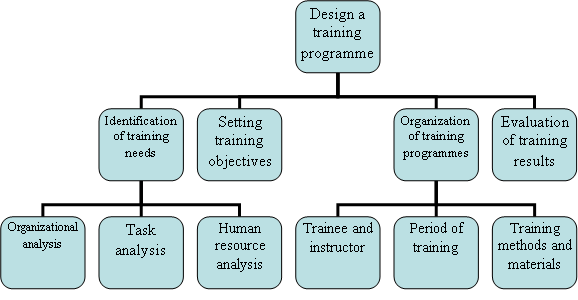How to design a training programme
Designing a training programme is very important part of human resource management. Let us discuss in this article how to design a training programme:
1) Identification of training needs: the main cause of identification of training needs is the technological changes that are taking place. For example computers are now days are used in all the offices which require training the employees. Except technological changes poor performance of workers which result in low production requires systematic training. Training needs can be identified through following types of analysis.
a) Organizational analysis: it is the systematic study of organization al objectives, resources, its utilization, growth potential and climate. It involves following elements:
i) Analysis of objectives: all the objectives of the organization whether long-term or short-term should be analyzed properly. It is the responsibility of the management to check which kind of training programme is required to achieve these objectives.
ii) Climate analysis: organizational climate shows the attitude of organizational members. It helps in checking whether the environment in different departments is conducive or not and where there is the need of training programme to improve the climate of the organization.
iii) Resource utilization analysis: it should be checked that whether the physical and human resources have been utilized properly or not otherwise there is the need of training to utilize them properly.
b) Task analysis: it is analyzing the job systematically. To identify the job contents, knowledge, skill, aptitude required to perform the job. In task analysis focus is on the job. It basically studies the various types of skills and training required to perform the job.
c) Manpower analysis: the quality or type of manpower the firm required should be checked properly. To achieve the proper quality standards specific training needs should be determined on the basis of capability of present workers to learn the new skills.
2) Setting the training objectives: after identification of training needs the next step is setting the training objectives. The aim of any training programme is to increase the organizational effectiveness. As each training programme must have specific objective like increase productivity, improved quality, higher the morale of employees, growth of employees, better human resource planning etc.

3) Organization of training programme: as every training programme include the trainees, trainers, training period, training material so all these should be organized properly.
i) Selection of the trainees: it is the first step of organization of training programme. The trainee should be selected properly. They should be trained for the kind of the job they like. Careful selection of the trainees helps in effectiveness of training programme.
ii) Preparation of instructor: instructor I the important person in the training programme. Qualified instructor may be obtained from inside the organization or from the outside. He must have all the qualities of good trainer because he has to give training to other people.
iii) Determination of training period: the time duration of training depends upon the type of skill required. For the training of clerk training of a week is enough while for any other position it may require more or less training time.
iv) Training methods: the on the job training and off the job training has been already discussed. So the choice of training methods depends upon the objective of the training programme.
4) Evaluation of training: at the end it is very important to evaluate the effectiveness of training programme. As how much the employees have learnt from the training programme. It will help in modifying the future training programme.
These are the steps to discuss how to design a training programme.